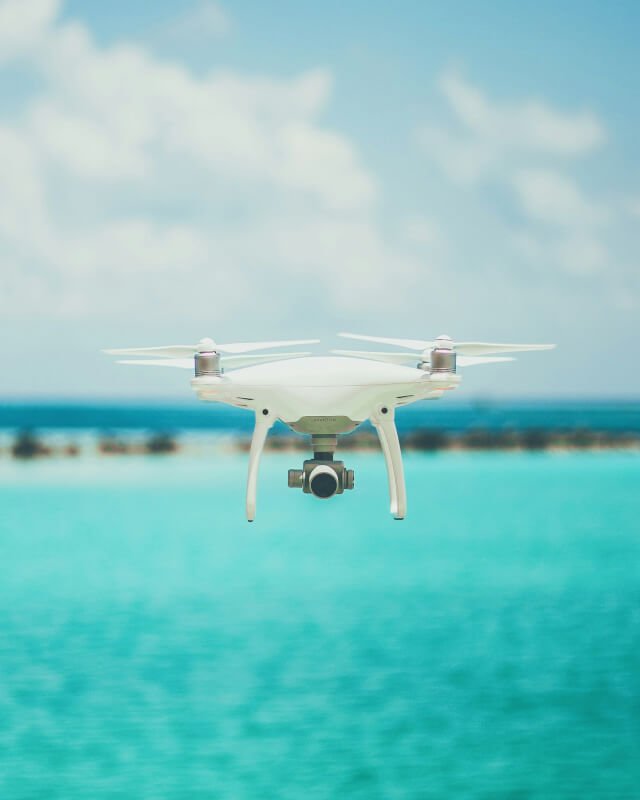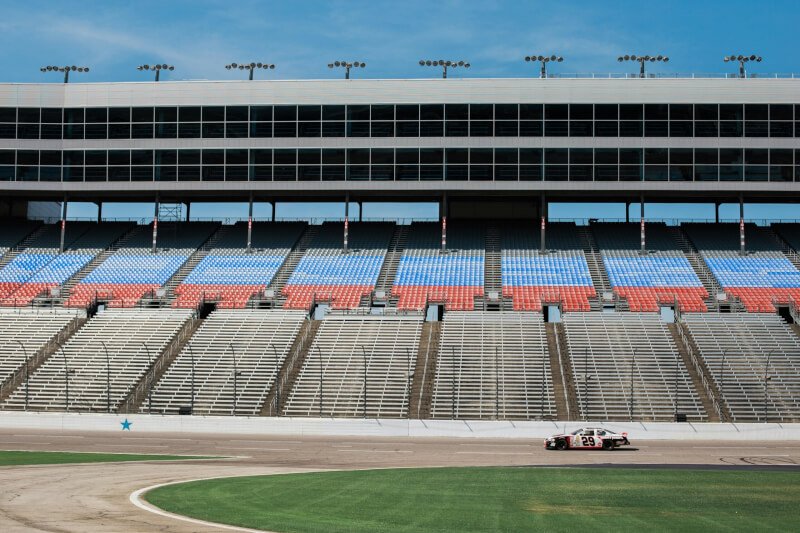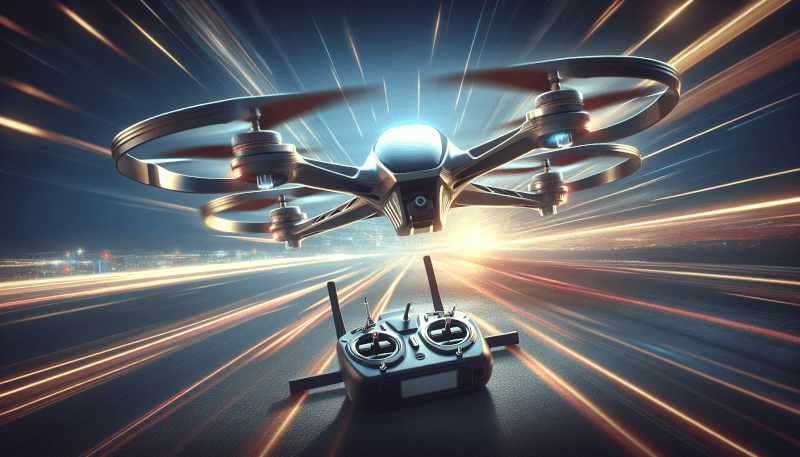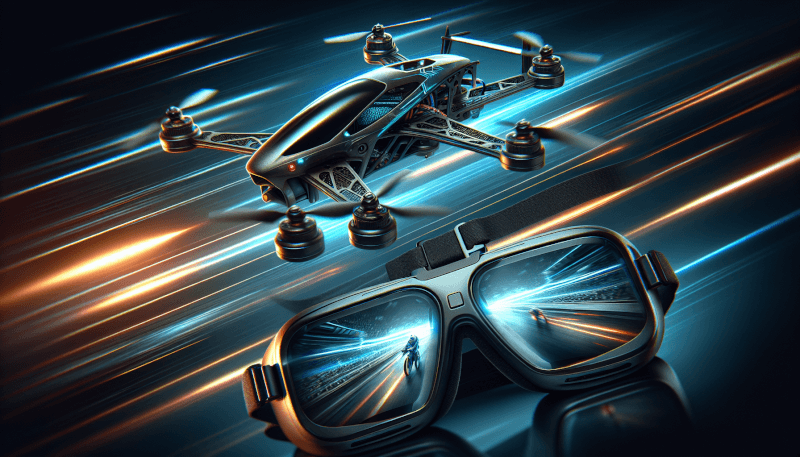Are you ready to soar to new heights and experience the thrill of drone racing? Look no further! In this beginner’s guide to drone racing equipment, we’ll take you through all the essential gear you need to get started in this exhilarating sport. From choosing the perfect racing drone to selecting the right goggles and other accessories, we’ll provide you with all the information you need to become a confident and competitive drone racer. So, strap in and prepare for an adrenaline-fueled adventure in the world of drone racing!

Drone Types
Racing Drones
Racing drones are designed specifically for high-speed competitive drone racing. These drones are lightweight, agile, and built for speed. They typically have a smaller frame and are equipped with powerful motors and high-performance propellers. Racing drones often come in kits that allow you to assemble and customize your drone according to your preferences. They are a great choice for adrenaline junkies and those looking to immerse themselves in the thrilling world of drone racing.
Ready-to-Fly (RTF) Drones
If you’re new to the world of drones and don’t have much experience building or customizing them, ready-to-fly drones are the perfect choice for you. RTF drones come pre-assembled and are ready to take flight right out of the box. They are equipped with all the necessary components, including the frame, motors, props, and flight controller. All you need to do is charge the batteries, calibrate the drone, and you’re ready to soar into the sky. RTF drones are an excellent option for beginners who want to get started quickly and easily.
Bind and Fly (BNF) Drones
For those who have some experience with drones and want more control over the customization process, bind and fly drones are a great option. BNF drones come without a transmitter, allowing you to choose your own compatible transmitter. You simply bind your transmitter to the drone’s receiver, and you’re ready to fly. This flexibility allows you to use a transmitter that suits your preferences and experience level. BNF drones are popular among intermediate and advanced drone enthusiasts who enjoy the freedom of selecting their own controller.
Frame Materials
Carbon Fiber Frames
Carbon fiber frames are the top choice for racing drones due to their strength-to-weight ratio. These frames are incredibly lightweight and provide excellent durability. Carbon fiber is a high-performance material that can withstand crashes and impacts without easily breaking or bending. The rigidity of carbon fiber frames helps maintain stability during high-speed maneuvers, ensuring optimal performance for racing drones. While carbon fiber frames may be more expensive, they are worth the investment for serious racing enthusiasts.
Plastic Frames
Plastic frames are a popular choice for beginners and those on a budget. They provide a more affordable option while still being relatively lightweight. Plastic frames are less rigid than carbon fiber frames, which can result in slightly reduced stability and durability. However, they still offer sufficient strength to withstand mild crashes and impacts. Plastic frames are a great choice for beginners who are just starting out in drone racing and want an affordable option that is easy to replace if damaged.
Aluminum Frames
Aluminum frames strike a balance between the lightweight nature of carbon fiber frames and the affordability of plastic frames. They offer good stability and durability while being reasonably priced. Aluminum frames are known for their sturdiness, making them suitable for beginners who want a durable and long-lasting drone. These frames also provide better protection for the internal components compared to plastic frames. Aluminum frames are a great choice for those seeking a balance between performance and budget.
Motor Types
Brushed Motors
Brushed motors are commonly used in entry-level drones and toy-grade drones. They are simple and inexpensive, making them an ideal choice for beginners. Brushed motors have brushes or contacts that deliver electric current to the magnets, causing them to spin. However, these motors tend to have shorter lifespans and lower overall performance compared to brushless motors. While brushed motors may not offer the same level of power and efficiency, they are still a reliable option for casual flying and learning the basics of drone operation.
Brushless Motors
Brushless motors are the preferred choice for racing drones and high-performance drones. These motors are more efficient, powerful, and durable than brushed motors. Brushless motors do not have contacts or brushes, resulting in reduced friction and wear. This allows for smoother and more precise control, better performance, increased flight time, and longer motor lifespan. Although brushless motors come at a higher price point, their superior performance and longevity make them a worthwhile investment for serious drone racers and enthusiasts.
Propeller Sizes
2-inch Propellers
2-inch propellers are commonly used in smaller racing drones designed for indoor flying or close-quarters racing. These propellers provide excellent maneuverability and agility due to their compact size. They are capable of quick acceleration and rapid changes in direction, making them ideal for navigating through tight spaces. However, due to their smaller size, 2-inch propellers might not generate as much thrust or top speed compared to larger propellers. They are suitable for beginners or those looking for a more controlled and precise flying experience.
3-inch Propellers
3-inch propellers are popular for racing drones that are used both indoors and outdoors. They strike a balance between maneuverability and speed. These propellers offer good thrust and stability, allowing for faster speeds and sharper turns. 3-inch propellers are versatile and can handle a variety of environments, whether it’s racing through a rugged outdoor course or zipping around obstacles indoors. They are a great choice for intermediate racers who want a balance between agility and power.
4-inch Propellers
4-inch propellers are commonly used in larger racing drones built for outdoor racing and long-distance flying. These propellers generate more thrust and speed, making them suitable for high-intensity racing and covering vast distances efficiently. 4-inch propellers provide stability and improved wind resistance, allowing for smoother flights even in slightly windy conditions. The larger size of these propellers also allows for a more substantial payload capacity, making them ideal for aerial photography or videography. Advanced racers and those seeking high-speed performance often opt for 4-inch propellers.

Battery Types
LiPo Batteries
LiPo (Lithium Polymer) batteries are the most common type of battery used in drones. These batteries offer high energy density, lightweight design, and high discharge rates, making them suitable for racing and high-performance applications. LiPo batteries provide the necessary power to run the motors, flight controller, and other electronic components of the drone. However, it is important to handle LiPo batteries with care and follow proper charging and storage procedures to avoid potential safety hazards. LiPo batteries are a popular choice for their performance and power output.
Li-ion Batteries
Li-ion (Lithium-ion) batteries are another type of rechargeable battery used in some drones. These batteries have a lower energy density compared to LiPo batteries but offer longer lifespans. Li-ion batteries are known for their stability, reliability, and ability to maintain a consistent voltage output even during discharge. They are a safer alternative to LiPo batteries but often have lower discharge rates. While Li-ion batteries may not provide the same level of performance as LiPo batteries, they are a suitable option for those who prioritize battery longevity and safety.
FPV Cameras
CMOS Cameras
CMOS (Complementary Metal-Oxide-Semiconductor) cameras are commonly used in FPV (First Person View) drones. These cameras provide high-quality image and video output with low latency, allowing pilots to have a real-time view of what the drone sees. CMOS cameras are known for their affordability, low power consumption, and ability to handle varying lighting conditions. However, they may be susceptible to issues such as rolling shutter effect, which can cause distortions in the image when the drone is moving quickly. CMOS cameras are a great choice for beginners and casual FPV flying.
CCD Cameras
CCD (Charge-Coupled Device) cameras are another option for FPV drones. These cameras offer superior image quality and are known for their more accurate color reproduction compared to CMOS cameras. CCD cameras provide better resistance to the rolling shutter effect, resulting in clearer and smoother images during fast movements. However, CCD cameras tend to be more expensive and consume more power compared to CMOS cameras. They are preferred by professional FPV pilots and those who require higher image quality for their aerial photography or videography projects.

FPV Goggles
Analog Goggles
Analog FPV goggles are the traditional option for immersing oneself in the first-person view experience. These goggles receive analog video signals from the drone’s camera and display the live feed on small screens inside the goggles. Analog goggles are typically more affordable than digital goggles and offer a wide range of options from various manufacturers. They provide a reliable and immersive FPV experience, although the image quality may not be as sharp as that of digital goggles. Analog goggles are a popular choice for beginners and hobbyists.
Digital Goggles
Digital FPV goggles utilize digital video transmission technology, providing a higher-quality image with reduced latency compared to analog goggles. These goggles often have higher resolution displays and offer a more immersive and visually appealing FPV experience. Digital goggles also have the advantage of better signal penetration and interference resistance, resulting in a more stable video feed. However, digital goggles tend to be more expensive than analog goggles and have a more limited selection of compatible drones and equipment. They are favored by professional FPV pilots and those who prioritize image quality and performance.
Transmitters (TX)
Mode 1 Transmitters
Mode 1 transmitters refer to a specific configuration of control sticks commonly used by pilots. In Mode 1, the throttle and yaw controls are on the right stick, while the pitch and roll controls are on the left stick. This configuration is popular in countries like Japan and Australia. Mode 1 transmitters are suitable for pilots who are accustomed to this control layout or find it more comfortable. It is essential to choose a transmitter that matches your preferred mode to ensure an intuitive flying experience.
Mode 2 Transmitters
Mode 2 transmitters are the most widely used control configuration for FPV drone pilots. In Mode 2, the throttle and yaw controls are on the left stick, while the pitch and roll controls are on the right stick. This configuration is popular in countries like the United States and Europe. Mode 2 transmitters provide a familiar and intuitive control layout for many pilots, as it mimics the control scheme of traditional radio-controlled aircraft. Choosing a transmitter in Mode 2 is recommended for beginners and pilots seeking the most common and widely supported control configuration.

Receiver (RX)
D8 Protocol
The D8 protocol is a popular communication protocol used by some transmitters and receivers. This protocol allows for up to eight channels of communication between the transmitter and the receiver. D8 receivers are commonly used with FrSky transmitters and are known for their compatibility and ease of use. They provide a reliable connection and are popular among beginner and intermediate pilots. D8 protocol receivers are a great option for those looking for a straightforward and user-friendly setup.
D16 Protocol
The D16 protocol is an advanced communication protocol that supports up to 16 channels. This protocol offers increased versatility and functionality, making it suitable for advanced pilots and those who require a higher number of channels for complex drone setups. D16 receivers are commonly used with FrSky transmitters and provide a robust and reliable connection. They often come with additional features such as telemetry, which allows pilots to monitor important flight data in real-time. D16 protocol receivers are a great choice for pilots who want expanded capabilities and flexibility.
Accessories
Antennas
Antennas play a crucial role in maintaining a reliable video and control signal between the drone and the transmitter or goggles. They come in various types, such as linear antennas and circular polarized antennas. Linear antennas provide a more focused signal in a specific direction, while circular polarized antennas offer better signal coverage and penetration. It is essential to choose antennas that match the transmission system and frequency range of your equipment to ensure optimal performance. Upgrading to high-quality antennas can significantly improve the range, stability, and signal strength of your FPV system.
Battery Chargers
Battery chargers are essential accessories for drone pilots, as they allow you to recharge your drone batteries efficiently and safely. There are various types of battery chargers available, including single-channel chargers and multi-channel chargers. Single-channel chargers can charge one battery at a time, while multi-channel chargers can charge multiple batteries simultaneously. Some chargers also offer additional features like balancing, which ensures that all the cells in the battery are charged equally. It is crucial to choose a charger that is compatible with your specific battery type and capacity.
Carrying Cases
Carrying cases are a must-have accessory for drone owners, as they help protect your equipment during transport and storage. These cases are designed to securely hold your drone, transmitter, batteries, and other accessories. Carrying cases often have foam inserts or compartments that offer protection against impacts and vibrations. They also provide convenient storage and organization solutions, making it easier to transport your drone to various locations. Investing in a high-quality carrying case ensures that your drone remains safe and well-protected, extending its lifespan and allowing you to enjoy many more flights.
In conclusion, understanding the different types of drones, frame materials, motor types, propeller sizes, battery types, FPV equipment, transmitters and receivers, and accessories is essential for every drone enthusiast. Whether you’re a beginner or a seasoned pilot, choosing the right equipment can greatly enhance your drone racing experience. By considering factors such as your skill level, budget, and specific requirements, you can make informed decisions to build or customize a drone that suits your needs. So, get ready to take to the skies and immerse yourself in the thrilling world of drone racing!



